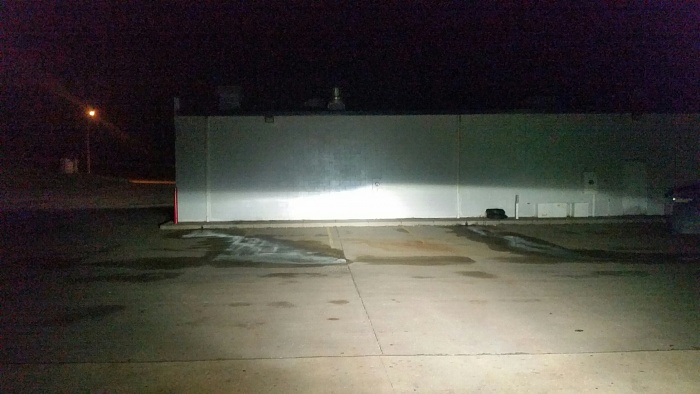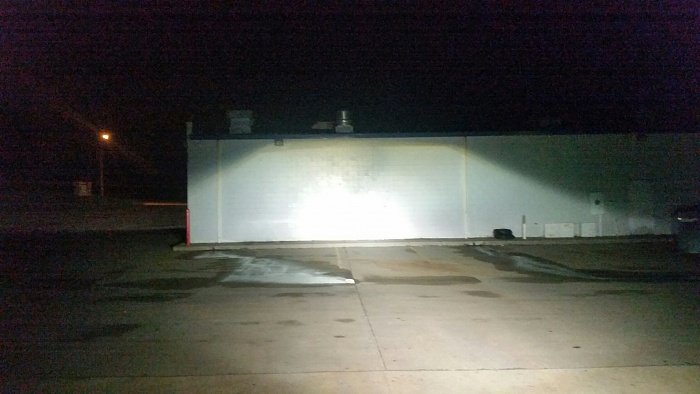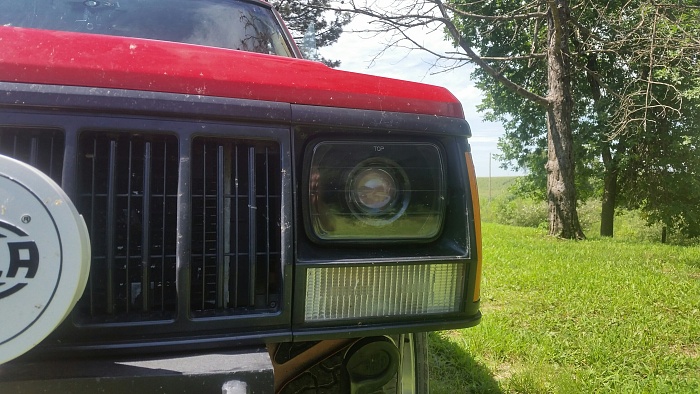Best Headlights for XJ, PICS would be nice as well!
#16
Senior Member
Joined: Mar 2012
Posts: 974
Likes: 12
From: Racine, WI
Year: 1997
Model: Cherokee
Engine: 4.0
The best headlights you can buy for the XJ are JW Speaker 8900's, but they are very expensive.
Anyway, read this
I've been seeing a lot of posts asking about headlights lately, and a lot of people making bad choices without even knowing what they're doing wrong. There is a lot of really good information out there, but most people don't have the time, skill, or discipline to research for themselves. The following is my attempt to gather information on the topic together into one place in the hopes that people will find this post and be able to answer their own questions. If that doesn't work, at least I'll have something of my own to quote instead of having to write a new response for everyone every time someone has a headlight question.
Put Them on Relays
Aim Them Properly
DOT and ECE
Optics and Light Characteristics
Products
Anyway, read this
Headlights
I've been seeing a lot of posts asking about headlights lately, and a lot of people making bad choices without even knowing what they're doing wrong. There is a lot of really good information out there, but most people don't have the time, skill, or discipline to research for themselves. The following is my attempt to gather information on the topic together into one place in the hopes that people will find this post and be able to answer their own questions. If that doesn't work, at least I'll have something of my own to quote instead of having to write a new response for everyone every time someone has a headlight question.
Put Them on Relays
When talking about headlights for the XJ, the first thing to discuss is their wiring because no matter what your question/concern is, if your headlights are still being powered by the factory wiring, you should change that. In the factory configuration, power for your headlights travels from the battery, through the power distribusion center (PDC) in the engine bay, to the switch in your dash, and then back up to the headlights. This is a problem for two reasons:
- All of the power your lights will use has to pass through your headlight switch. This often leads to damage/melting of the headlight switch and sometimes can even start a fire especially if you're using bulbs that are a higher wattage than stock.
- Voltage drop. As energy passes through wire and switches, voltage is lost. What begins as 12 volts at your battery becomes significantly less by the time it reaches your headlights. Small gauge wire exacerbates the problem of voltage drop, and the factory headlight wiring is quite small. A 10% drop in voltage (a little more than 1 volt) reduces headlight output to 2/3 of its maximum potential!
Aim Them Properly
The next most important thing is aim. Improperly aimed headlights waste light and can endanger oncoming traffic. So many drivers never aim their headlights. They assume that they're aimed correctly from the factory and that aim never changes or needs to be adjusted. Or maybe they assume that their mechanic checks and adjusts aim for them. Or maybe they just never think about it at all. Aim does need to be checked and readjusted periodically, and, no, your mechanic does NOT do this for you unless specifically asked. If you get new headlights, you should check and readjust your aim. If alter your suspension in any way, you should check your aim (because your entire XJ may not be "aimed" the same as before). If you're going on a long trip with a lot of cargo and/or a trailer, readjust your aim because that weight might be enough to tilt your headlights too high. Heck, pothole hits, fender-benders, or a particularly rough day of wheeling can throw your aim off. Aiming your headlights is extremely easy to do. Instructions that work for any vehicle can be found HERE
DOT and ECE
Even with a relay harness, many people will still want better lighting as the stock sealed-beam headlights are still disappointing in a number of ways. First, I'd like to discuss the two prevailing lighting standards in the world because they are quite different from each other, and which you are comfortable choosing will determine which products you'll be able to choose from for upgrades.
First, there is the American SAE/DOT standard. This standard is technically mandatory in the US and allowed in Canada and Mexico. Second, there is the European ECE (aka E-code) standard. This standard is required or at least allowed in every other country in the world. The biggest difference between the two is how they control low-beam glare and how much of a priority that control is.
When it comes to the product advice that I give at the end of this post, all recommendations are for ECE versions where applicable because it is my contention that ECE is the superior lighting standard.
First, there is the American SAE/DOT standard. This standard is technically mandatory in the US and allowed in Canada and Mexico. Second, there is the European ECE (aka E-code) standard. This standard is required or at least allowed in every other country in the world. The biggest difference between the two is how they control low-beam glare and how much of a priority that control is.
Disclaimer: I have an extremely low opinion of American DOT regulations for reasons I won't necessarily clutter this post with, and while I will attempt to remain objective, I feel I must make everyone aware of this since no one can ever opterate without bias, and anyone who claims otherwise is lying to your and/or themselves.
DOT allows more glare than ECE and also allows much more gradual transitions from bright to dark throughout its pattern. The top of the low-beam pattern in DOT lights is also not standardised: sometimes it has no sharp cutoff; sometimes it has a sharp cutoff on one side or the other; sometimes it has a flat cutoff clear across the top of the pattern. ECE is more stict about its cutoffs, especially at the top of the low-beam. ECE's pattern allows the light to "kick-up" on one side of the pattern in order to illuminate more of the side of the road and to illuminate signs. This "kink" in the cutoff makes it very important that you select the correct product because most ECE headlights have two versions: one for RHD countries and one for LHD countries. The "kink" in the cutoff also allows precise left/right aiming of the beam--something that the American DOT is hesitant to admit is even possible; DOT headlights can only be aimed left/right with the use of special machinery. Most auto shops do not even own this machinery anymore. Both standards leave enough room for bad products to exist and still comply. Just because something is DOT or ECE approved does not mean it isn't a bad product.When it comes to the product advice that I give at the end of this post, all recommendations are for ECE versions where applicable because it is my contention that ECE is the superior lighting standard.
Optics and Light Characteristics
Next, let's cover some of the basic properties of headlights. Some of these are pretty technical and of limited practical importance for XJ headlights, so I'll try to keep it short and sweet. You can always do some deeper research on your own or ask me questions if this stuff interests you.
The optics of our headlights are usually one of the following three:
The optics of our headlights are usually one of the following three:
- Reflection. Light from the bulb is reflected and focused off of the back of the housing. Rampage housings are a decent example of this method being used. http://www.quadratec.com/Assets/Imag...8/67238-lg.jpg
- Projection. Light from the bulb is focused through a lens. There are projectors for halogen, HID, and LED lights. For XJ's, projectors are most common in HID retrofits, and in one of our two top LED headlight choices. Most times a "projector" occurs in a halogen housing for an XJ, it is a crappy gimmick of low quality and not a true projection headlight. With the perfection achieved by many reflected and fluted halogen housings, my advice is to simply avoid halogen projectors for the XJ unless you know exactly what you're doing. A writeup on how to perform an HID projection retrofit can be found HERE.
- Fresnel lens/fluting. This method is very common for halogen housings and utilyzed by most of the best. Fluting allows very precise control over where light goes by dividing the lens into many different angular sections/prisms. An example of this method can be seen in this Cibie housing http://dsl.torque.net/images/200HRC.jpg
- Spectral power distribution (SPD). Bascially, light sources are usually composed of a spectrum of different wavelengths of light, but it's usually not a perfectly even distribution of all the wavelengths. A particular light source may be more intense/powerful in one wavelength and relatively weak in another. Imagine a line graph across the whole spectrum of visible light with peaks and valleys as it goes from violet to red. Here is a simplified example of various SPD's to help you visualize the concept.

- Correlated color temperature (CCT). Without getting very technical, this is the overall hue of a light source described in kelvin (K). This is a very common characteristic used by HID bulbs for two reasons. HID bulbs can be easily made to emit light in a variety of CCT. The misconception that CCT = brightness has been planted in the minds of many consumers, so the belief is rampant that a higher K bulb is somehow better/brighting than a lower K bulb. This leads to people buying cheap 8000, 9000, or even 12000K HID's that are awful for visibility thinking that they are somehow better. Daylight tends to be around 5000-6000K depending on angle of the sun or weather conditions. When selecting a headlight, anything from 4000-6000K will be quite effective. Higher or lower are not better, can actually create problems, and will likely attract the attention of law enforcement.
- Color rendering index (CRI). Diffrent light sources are capable of rendering the true colors of objects to diffrent degrees. This ability is described on a scale of 1-100. While it is debatable how important CRI is to headlights as long as colors can be rendered enough that one can still understand traffic signage, I submit that higher CRI is better if you can achieve it because there is less chance of an object or person appearing to be "camoflaged" against their surroundings with a better CRI. Here examples before and after switching from low CRI street/parking lot lighting to higher CRI lights. Notice how the first images are almost completely "yellowscale" kind of like a sepia phtotograph?
No headlight to my knowledge has such a low CRI as those "before" shots, but hopefully those help you understand what good color rendering can do.


Products
Let's finally talk about the lights people so often jump straight to asking about.
Additional reading and photos can be found at:- Our stock headlights were sealed-beam halogen. The "sealed-beam" part refers to the fact that the bulb and the housing are one piece. These tend to be of poor quality and generate a lot of waste. When it comes time to replace them, I suggest you buy a quality set of H4 halogen housings and H4 halogen bulbs. Halogens are relatively inexpensive both for their housings and for replacement bulbs. They have a continuous SPD that tends to be fairly strong in the longer wavelengths, a very good CRI, and a lower CCT usually around 4000.
My recommendations for housings include:- Autopal
- Hella
- IPF
- Cibie
- Also common these days are high-intensity discharge (HID) headlights. These are controversial mostly because of the ignorance of consumers leading them to buy poor-quality products and misuse them in ways that are very dangerous for themselves and others on the road. Because an HID bulb uses an arc through a tube of gas much like a flourescent bulb instead of a filament like a halogen, optics for one CANNOT be used for the other.
Details regarding the difference in HID lighting vs halogen and its benefits/drawbacks can be read HERE. Because Daniel Stern does such a good job, I won't reinvent the wheel and clutter this post.
HID has a discontinuous SPD, relatively low CRI, and CCT can vary.
If you want HID, buy a quality product and use quality HID projectors. I like Morimoto projectors from theretrofitsource.com, but I am less knowledgable about HID than halogen or LED options, so make sure to do some of your own research because maybe there is a better choice out there these days. - Becoming more and more popular these days is light-emitting diode (LED) lighting. LED's need less energy than halogen to generate the same amount of light, but more energy than HID. They generate heat, but not much, and the heat is not near nor easily directed to the lens of the headlamp which can make them problematic in very cold/snowy/icy areas--without enough heat on the lens, the headlights can end-up getting covered in snow/ice. They are extremely long-lived--lasting 10-50+ times longer than halogen bulbs and 20+ times longer than HID. They are very durable, and virtually unaffected by physical shocks/jolts unlike more fragile halogen and HID bulbs who can have their lifespans reduced or even ended simply from all the "rough-housing" a Jeep owner may put them through while wheeling.
They have a discontinuous SPD but can emit white light without having to use a lot of disruptive blue wavelengths to do it. This ability of theirs is actually causing a lot of lighting science to shift and reevaluate how light is described and used.
I am only aware of two choices worth consideration at this time: Truck Lite and JW Speaker. I feel the JW Speaker is significantly superior, but they much more expensive than the already expensive Truck Lites. JW Speaker also has a model for XJ Wagoneer guys who have a headlight size that can be very difficult to replace with something of high quality.
Before anyone asks, no, LED "bulbs" that plug into halogen housings are not a good choice.
- http://danielsternlighting.com/tech/bulbs/bulbs.html
- http://danielsternlighting.com/tech/relays/relays.html
- http://danielsternlighting.com/tech/...uperwhite.html
- http://www.jkowners.com/tech/lights/
- http://www.naxja.org/forum/showthread.php?t=1082758 (It's a long thread, but there are a lot of useful posts to find throughout, not just on page 1; the OP eventually left Truck Lite for JW Speaker).
- https://www.cherokeeforum.com/f67/ju...9/#post2653796
http://www.digikey.com/en/articles/t...olor-rendering
#17
Senior Member

Joined: Sep 2015
Posts: 922
Likes: 65
From: Abysmo, NJ
Year: 1999
Model: Cherokee
Engine: 4.0
Low beam w/OEM lighting:

Low beam w/Autopal E-Code kit:
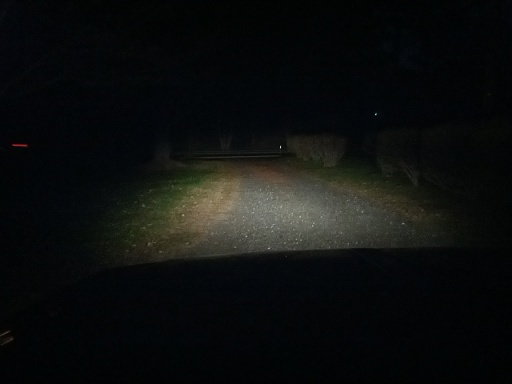
High beam w/OEM lighting:
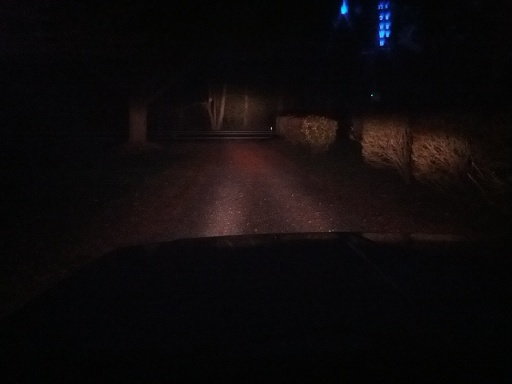
Low beam w/Autopal E-Code kit:

The major difference is in the performance of the low beams. Since I stuck with standard wattage bulbs the high beam difference is not as striking, but probably would be with more powerful bulbs.
#18
::CF Administrator::

Joined: Feb 2011
Posts: 14,474
Likes: 790
From: Blunt, South Dakota
Year: 97
Model: Cherokee (XJ)
Engine: 4.6 stroker
The light output isn't the only benefit of these, they also have a clean cutoff, and don't scatter the light, and it's a nice bright white light, not yellow like incandescents, and not blue or purple like some of the HID's out there. I have NEVER been flashed, and I have them set a tad high, and I'm lifted as well.
#19
CF Veteran
Joined: Jul 2012
Posts: 3,009
Likes: 260
From: Andover, VT
Year: 1999
Model: Cherokee (XJ)
Engine: 4.0 L
I'm running H4s in e-code housings with a relay harness. The harness made the lights brighter. The e-code housings gave them a better pattern. For me, beam pattern is important. I don't want to blind oncoming traffic with some garbage Chinese LEDs that spray light everywhere, because I'm not an a55hole.
-Cibiť housings
-55/60w Osram bulbs
-Putco harness
#20
Best "Bang for the Buck" are the Trucklites. They are not the best performing but they are the most cost effective for the amount of light they provide & simplest to install.
If you want the best performance then the JW Speakers or a set of Projector Retrofit HID's are where it's at.
I have seen all 3 in person & I have 2 of them (Trucklites & Retrofit HID) myself.
If you want the best performance then the JW Speakers or a set of Projector Retrofit HID's are where it's at.
I have seen all 3 in person & I have 2 of them (Trucklites & Retrofit HID) myself.
#21
CF Veteran
Joined: Jul 2013
Posts: 1,466
Likes: 6
From: St. Joseph, MO
Year: 1994
Model: Cherokee
Engine: 4.0
#22
CF Veteran
Joined: Aug 2009
Posts: 1,127
Likes: 12
From: 9000 ft, CO
Year: 1999 XJ
Model: Cherokee
Engine: I6 4.0L
I've been happy with the Trucklites too. They don't draw much power so you won't need to upgrade your stock wiring. An added bonus is that if your stupid headlight buzzer works intermittently and you forget to turn them off, they won't drain your battery, even for a couple of hours.
The only thing I don't like about them is driving with them in snowstorms. The LED's don't generate enough heat to keep frost off the housings.
And as for the price- you won't ever replace an LED bulb, so think of it as the last pair of headlights/bulbs you'll ever have to replace.
Considering the ease of install, low impact on your alternator and battery, and the longevity of LED's, you'd be better off saving up for a set of Trucklites.
The only thing I don't like about them is driving with them in snowstorms. The LED's don't generate enough heat to keep frost off the housings.
And as for the price- you won't ever replace an LED bulb, so think of it as the last pair of headlights/bulbs you'll ever have to replace.
Considering the ease of install, low impact on your alternator and battery, and the longevity of LED's, you'd be better off saving up for a set of Trucklites.
#23
Senior Member
Joined: Jun 2014
Posts: 925
Likes: 6
From: Eagle River, Alaska
Year: 1999
Model: Cherokee (XJ)
I ended up returning my trucklites after a couple days use. Just wasn't enough of an upgrade for my 5 minute drive to work for the price. In retrospect, I wish I kept them and will probably rebuy them one day.
#24
CF Veteran
Joined: Oct 2013
Posts: 2,097
Likes: 11
From: Tarpon Springs, FL / Denver, CO
Year: '98
Engine: 4.0 I6
I prefer 55w bi-xenon HIDs in a properly retrofitted housing.
They are brighter than my friends Truck Lites, we're a bit cheaper, and produce enough heat to keep the headlight lens clear during snowstorms (very important!!). My friend can't drive more than 30 minutes through a blizzard without stopping to wipe his lights off.
Plus the cutoff is mesmerizing...
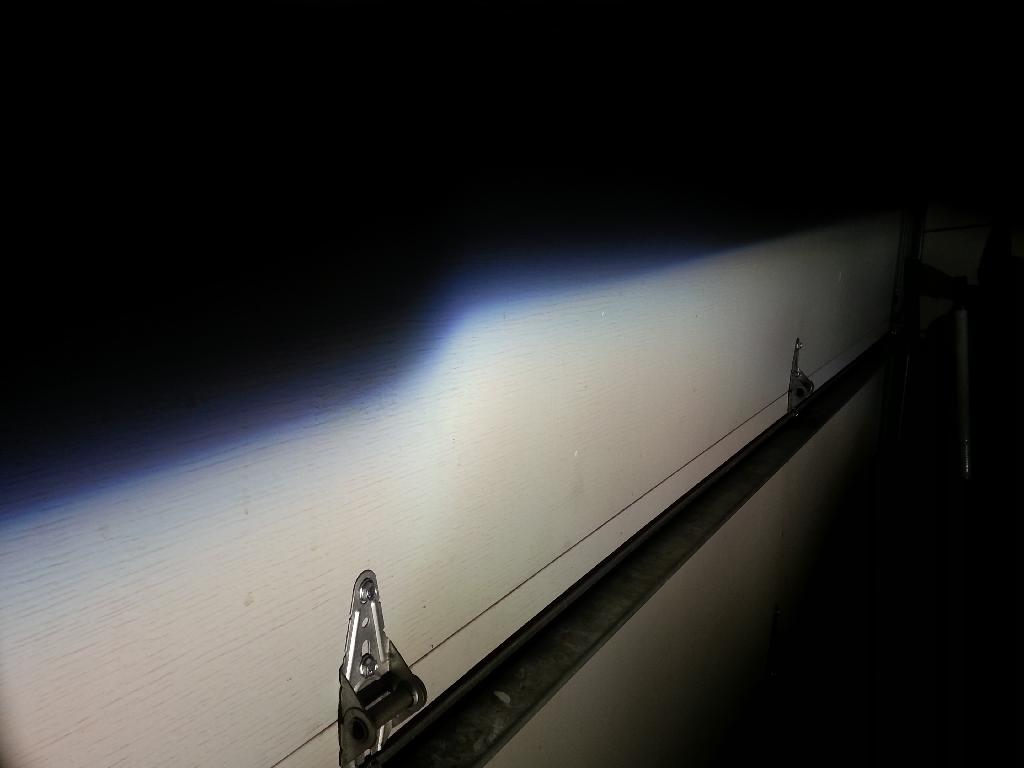
They are brighter than my friends Truck Lites, we're a bit cheaper, and produce enough heat to keep the headlight lens clear during snowstorms (very important!!). My friend can't drive more than 30 minutes through a blizzard without stopping to wipe his lights off.
Plus the cutoff is mesmerizing...

#25
Love my Trucklites and i live in big time snow country. When it snows i simply turn on my Hellas and all is well. Depends on the moisture content of the snowstorm if it will stick or not.
#26
Banned
Joined: Feb 2014
Posts: 2,379
Likes: 17
From: Florida
Year: 2000
Model: Cherokee(XJ)
Engine: Golen 4.6L
There's a heated version of the round Truck Lites for the Wranglers, with a heating element inside the glass to melt away snow and ice. I can't understand why they haven't introduced a heated version of the rectangular ones for our Jeeps. Beside the cost differential, the lack of heaters is the main reason I went with H4s instead.
I actually bought a set of HID projectors for my Jeep, but in the end I opted not to use them for similar reasons. I read stories of people drowning their ballasts and having their headlights crap out. Even though I drive primarily on the road, the main purpose of my build is to have a fairly capable bugout vehicle that I can rely on when the **** hits the fan. Lights that freeze over in snow or die altogether in deep water and then require a few days for replacement parts to arrive sort of defeat the purpose. Sealed beam headlights still rule that space, but I think the H4s are a decent compromise with better water resistance than HIDs and enough heat to melt snow. Plus I can carry an extra set of bulbs in case they do crap out, whereas carrying a spare set of ballasts for HIDs isn't really practical.
I actually bought a set of HID projectors for my Jeep, but in the end I opted not to use them for similar reasons. I read stories of people drowning their ballasts and having their headlights crap out. Even though I drive primarily on the road, the main purpose of my build is to have a fairly capable bugout vehicle that I can rely on when the **** hits the fan. Lights that freeze over in snow or die altogether in deep water and then require a few days for replacement parts to arrive sort of defeat the purpose. Sealed beam headlights still rule that space, but I think the H4s are a decent compromise with better water resistance than HIDs and enough heat to melt snow. Plus I can carry an extra set of bulbs in case they do crap out, whereas carrying a spare set of ballasts for HIDs isn't really practical.
#27
CF Veteran
Joined: Aug 2009
Posts: 1,127
Likes: 12
From: 9000 ft, CO
Year: 1999 XJ
Model: Cherokee
Engine: I6 4.0L
There's a heated version of the round Truck Lites for the Wranglers, with a heating element inside the glass to melt away snow and ice. I can't understand why they haven't introduced a heated version of the rectangular ones for our Jeeps. Beside the cost differential, the lack of heaters is the main reason I went with H4s instead.
That's where a pair of these http://www.ebay.com/itm/Kimpex-ATV-S...-/161794128899
come in handy.
They keep the housings warm enough that the only light interference is the melted ice dripping off the face of the light.
#28
Banned
Joined: Feb 2014
Posts: 2,379
Likes: 17
From: Florida
Year: 2000
Model: Cherokee(XJ)
Engine: Golen 4.6L
That's where a pair of these http://www.ebay.com/itm/Kimpex-ATV-S...-/161794128899
come in handy.
They keep the housings warm enough that the only light interference is the melted ice dripping off the face of the light.
come in handy.
They keep the housings warm enough that the only light interference is the melted ice dripping off the face of the light.
#29
CF Veteran
Joined: Aug 2009
Posts: 1,127
Likes: 12
From: 9000 ft, CO
Year: 1999 XJ
Model: Cherokee
Engine: I6 4.0L
#30
Banned
Joined: Feb 2014
Posts: 2,379
Likes: 17
From: Florida
Year: 2000
Model: Cherokee(XJ)
Engine: Golen 4.6L
Don't these housings have a big heat sink on the back to draw off the heat from the drivers so they don't cook themselves? If you put these warmers on the bottom of the housings, what's to keep them from cooking the drivers anyway?



